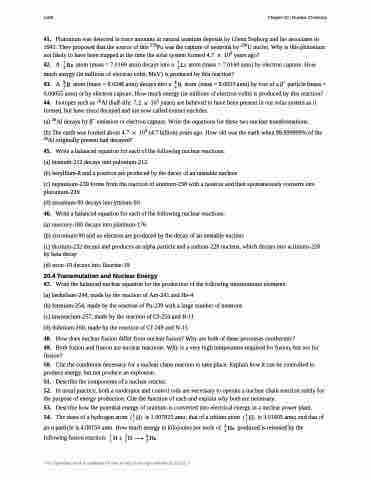Page 1168 - Chemistry--atom first
P. 1168
1158 Chapter 20 | Nuclear Chemistry
41. Plutonium was detected in trace amounts in natural uranium deposits by Glenn Seaborg and his associates in 1941. They proposed that the source of this 239Pu was the capture of neutrons by 238U nuclei. Why is this plutonium not likely to have been trapped at the time the solar system formed 4.7 � 109 years ago?
42. A �� �� atom (mass = 7.0169 amu) decays into a �� �� atom (mass = 7.0160 amu) by electron capture. How
much energy (in millions of electron volts, MeV) is produced by this reaction?
43. A �� � atom (mass = 8.0246 amu) decays into a �� � atom (mass = 8.0053 amu) by loss of a β+ particle (mass =
0.00055 amu) or by electron capture. How much energy (in millions of electron volts) is produced by this reaction?
44. Isotopes such as 26Al (half-life: 7.2 � 105 years) are believed to have been present in our solar system as it formed, but have since decayed and are now called extinct nuclides.
(a) 26Al decays by β+ emission or electron capture. Write the equations for these two nuclear transformations.
(b) The earth was formed about 4.7 � 109 (4.7 billion) years ago. How old was the earth when 99.999999% of the 26Al originally present had decayed?
45. Write a balanced equation for each of the following nuclear reactions:
(a) bismuth-212 decays into polonium-212
(b) beryllium-8 and a positron are produced by the decay of an unstable nucleus
(c) neptunium-239 forms from the reaction of uranium-238 with a neutron and then spontaneously converts into plutonium-239
(d) strontium-90 decays into yttrium-90
46. Write a balanced equation for each of the following nuclear reactions:
(a) mercury-180 decays into platinum-176
(b) zirconium-90 and an electron are produced by the decay of an unstable nucleus
(c) thorium-232 decays and produces an alpha particle and a radium-228 nucleus, which decays into actinium-228 by beta decay
(d) neon-19 decays into fluorine-19
20.4 Transmutation and Nuclear Energy
47. Write the balanced nuclear equation for the production of the following transuranium elements: (a) berkelium-244, made by the reaction of Am-241 and He-4
(b) fermium-254, made by the reaction of Pu-239 with a large number of neutrons
(c) lawrencium-257, made by the reaction of Cf-250 and B-11
(d) dubnium-260, made by the reaction of Cf-249 and N-15
48. How does nuclear fission differ from nuclear fusion? Why are both of these processes exothermic?
49. Both fusion and fission are nuclear reactions. Why is a very high temperature required for fusion, but not for
fission?
50. Cite the conditions necessary for a nuclear chain reaction to take place. Explain how it can be controlled to produce energy, but not produce an explosion.
51. Describe the components of a nuclear reactor.
52. In usual practice, both a moderator and control rods are necessary to operate a nuclear chain reaction safely for
the purpose of energy production. Cite the function of each and explain why both are necessary.
53. Describe how the potential energy of uranium is converted into electrical energy in a nuclear power plant.
54. The mass of a hydrogen atom ��� �� is 1.007825 amu; that of a tritium atom ��� �� is 3.01605 amu; and that of
an α particle is 4.00150 amu. How much energy in kilojoules per mole of �� �� produced is released by the following fusion reaction: �� � � �� � � �� ���
This OpenStax book is available for free at http://cnx.org/content/col12012/1.7


